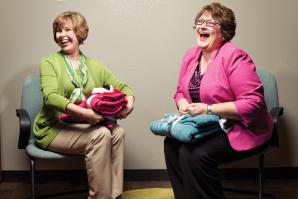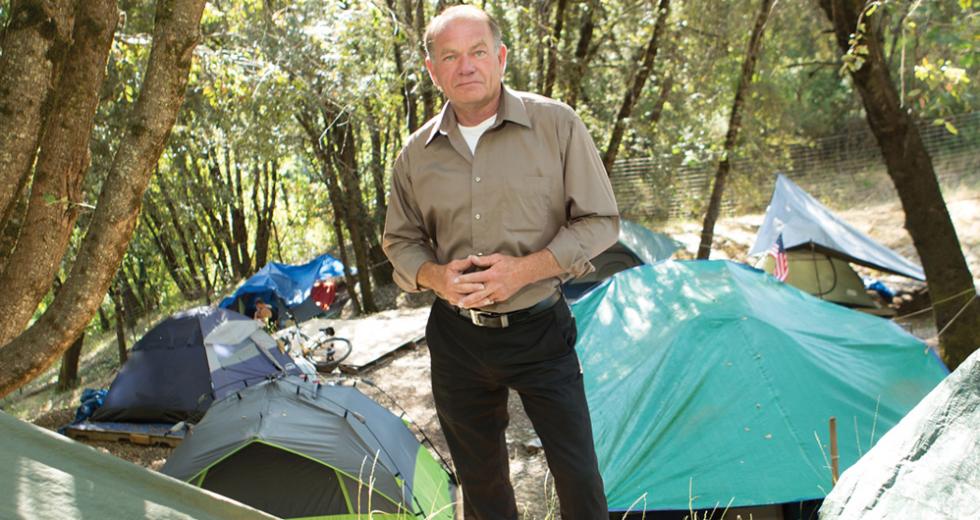A little more than six years ago, the El Dorado Community Foundation tapped William Roby to become its new executive director. Roby had been working for the foundation for only a year as its program director, but the board was seeking a fresh personality to lead the organization. Since then, Roby has concentrated on one goal: getting the foundation to a point of fiscal sustainability so it can pay its own way.
“At first, they asked me to become interim director,” he recalls. “I said yes, but with one provision: If they were going to ask me to lead, that’s exactly what I was going to do. I would lead. That’s what I’ve done ever since.”
In 1995, the foundation was formed by a group of board members from New Morning Youth and Family Services who wanted to create a mechanism that would enable all El Dorado County nonprofits to become independent from government contracts.
Prior to joining the foundation, Roby had spent seven years working with a nonprofit in the East Bay. He has a bachelor’s degree in business administration from the State University of New York and completed a public health residency at Princeton University Hospital. While he admits to enjoying his stint in the Bay Area, Roby longed to settle on a larger plot of land, perhaps somewhere that held a hint of nostalgia.
“As a youngster, my parents would put me on a Greyhound to Placerville where my grandma lived. I have fond memories of those summers,” he says. “I was very close to my grandma — she taught me how to drink beer and fish.” Today, Roby resides on 10 acres in Shingle Springs along with three horses.
Over a recent conversation with Comstock’s, he shared insight on how close the foundation is to achieving financial independence and which issues the organization is spending much of its time and resources addressing.
“When I became director, the foundation’s assets were at about $6.1 million. Today, we are very close to $12 million. We have had phenomenal growth in the past couple of years during a very bad economy, and a majority of those gifts have come from individual donors in very small amounts. That speaks volumes about our local giving community and the trust they have in the foundation.”
“My plan for my first five years was to get this foundation to sustainability. That was critically important along with providing quality leadership to our donor base and quality services to the community. We are very close to sustainability. We have achieved our goals of leadership and service. Today, the foundation is seen as a repository of community knowledge and a facilitator when it comes to community problems.”
“We step in. We don’t take a side on a community issue. It’s our job to help both parties understand the complete picture and what each other’s perspectives are. We help find solutions through collaboration. One of the foundation’s strengths is its ability to help resolve some of the community’s most complex problems, such as homelessness, foster youth and economic development. Those are things that most regional foundations typically either downplay or don’t get heavily involved with.”
“We see two very distinct homeless population sets. One is chronic, the other is situational. For the situational, there are certain circumstances that have happened in their lives that have lead them to their current predicament. Oftentimes, mistakes or poor judgments have been made. However, sometimes circumstances totally out of their control have propelled them into homelessness. With our community partners, we are doing everything we can do to serve this population and to help get them back on their feet.”
“Our homeless camp, Hangtown Haven, is very restrictive. There are only 40 to 60 people there at any one time, and campers have to prove they are residents of the city of Placerville. Once we move it to a new location in the county off Missouri Flat Road, they will have to prove they are a resident of El Dorado County. This is not a port for everyone that wants to build on it. This is for county residents who are trying to get out of their homeless situation.”
“Chronic homelessness is a much different problem that has to be addressed with a lot more care. Many of these people have mental health illness, oftentimes combined with substance abuse issues. So you have multiple complexities. You can’t ignore the problem. We rely on help from our health services as well. We have to bring it to some type of resolution, but that is a little further off than finding a resolution for the situational homeless.”
“In five years, I would like to see us resolve homelessness in El Dorado County and become a model for the state. What’s so wonderful about living and working in a rural community is that we’re small enough to still get our arms around our problems. In Sacramento, you’re dealing with a homeless population of about 13,000. Here, we’re talking about less than 1,000. Our conversation is much easier to have. We have the ability to resolve the problems and develop a model program that can be replicated throughout the state. I’m confident we can do that.”
“I see us becoming an incubator for problem resolution. As a sound foundation in a small community, we have the ability to address some of the real difficult issues we face, not only as a rural area, but also as a state and a nation. I’m a strong believer that small communities have the flexibility to get things like homelessness and foster youth care resolved.”
“Too often, I believe our service program models create a revolving door, where people come in and then go back out again. As a foundation, we don’t want to spread the veil of giving so thin that we don’t achieve anything. We want to take on something. Resolve it. Build it to sustainability. Then move on to the next issue knowing that what we have done is in good hands. That’s our challenge.
“One of my favorite stories is about a family we helped out that was having a transportation issue. They needed to purchase four new tires. They were basically driving on four bald tires. It became a safety issue to the point kids were not getting to school, and dad wasn’t getting to work. We worked with a nonprofit partner, got a quote for $700 and got the family the money to purchase the tires. A couple weeks later, we got in the mail an envelope with $2.75. That was the change the family got from the tire purchase. That shows how grateful they were. They wanted nothing more than the new tires.”
“Five years from now, I would like to see our assets doubled again. I would like to see the staff here grow beyond our current capacity. In order for us to do that, we have to financially build our assets. That growth is not for just growing our staff. That growth is so we can provide even more quality services for our donors and to our community.”
Recommended For You

United We Stand
Done wisely, nonprofit mergers can boost economic vitality
In the fall of 2011, the executive directors of the Sacramento Philharmonic and the Sacramento Opera sat in their respective offices staring bleakly at financial reports that were telling each of them what they already knew:

Expanding a Vision
New leadership means fresh ideas for Women in Philanthropy
Banning together 12 years ago, a group of local women sought out to help foster youth establish healthy lives after emancipation.



